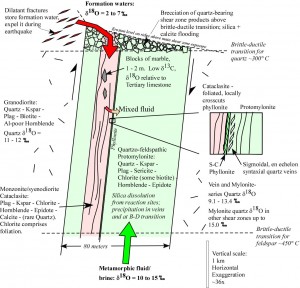Losh, S., 1989, Amer. Jour. Sci. v 289, pp. 600-648
Exhumed high-angle ductile-brittle shear zones preserve evidence of the evolution of fluid flow and mechanical behavior of faults in compressional regimes. Two Eocene (“Alpine” orogeny – aged) shear zones in the Neouvielle granodiorite massif, in the central French Pyrenees, contain products formed in both ductile and brittle regimes. These faults are believed to merge with a low-angle dominant Alpine-aged thrust about 4 km below the surface. The present erosion level lay at a depth of about 10 km during faulting. Mineralogical and stable isotope geochemical data show that the retrograde greenschist-facies shear zones hosted large quantities of high-d18O metamorphic fluid derived from overthrust footwall sediments. One shear zone also contains cataclasite that was infiltrated by basinal fluids derived from the overlying sedimentary section.
Others have subsequently studied this shear zone and found high-salinity fluid inclusions characterized by high Br content typical of evaporated seawater that is thought to have been derived from redbeds below the thrust sheet (Henderson and McCaig, 1996 Tectonophysics). I have found no evidence for these inclusions, which are reported to contain daughter minerals, in any samples from the shear zones; however, the conclusion that high-salinity fluids were present in the shear zone adds some noteworthy detail to the main conclusion that the shear zone channeled large amounts of fluids derived from below.
Of particular interest is the “Pic Long Shear Zone” in the southern part of the granodiorite massif. This shear zone is shown schematically in Figure 1. This steeply-dipping shear zone contains mylonite-series products derived from a quartz-bearing granodiorite precursor, and cataclasites derived from a quartz-deficient monzonite/syenodiorite precursor. Although on a broad scale both parts of the fault moved simultaneously, the two types of fault product are very different in terms of mechanics of faulting and source of infiltrated fluid. The ductile shear zone products comprise protomylonite, mylonite, and phyllonite in which feldspars have been retrograded to sericite. Biotite and, to a lesser extent, hornblende, have been altered to chlorite +/- epidote. Small quartz +/- chlorite veins are present throughout the mylonite exposures. The ductile shear zone products commonly have d18O that is higher than the granodiorite from which they were derived. Only on a high ridge are these ductile products brecciated and extensively veined by quartz and calcite in what is interpreted as the base of the brittle regime (for quartzofeldspathic rocks) during faulting. In contrast to the ductile shear zone products, the foliated cataclasite consists of brittly-deformed feldspar that has not been altered, chlorite, and calcite, which forms groundmass and veins in the cataclasite. This calcite was precipitated by fluid having d18O that was several permil lower than that of the ascending fluid. The cataclasite also contains some lens-shaped pods of protomylonitic rocks and two enigmatic pods of marble tectonite. Where quartz is (rarely) seen in the cataclastic unit, it is dynamically recrystallized, indicating the cataclasite and mylonitic rocks deformed simultaneously.
Clearly, at least two different fluids were present in the Pic Long Shear Zone: one that produced a retrograde greenschist-facies assemblage in the ductile portion and one that precipitated calcite but did not alter feldspars in the cataclastic portion. The cataclasite fluid was of significantly lower d18O than the mylonite fluid, and its infiltration into the mylonite-series products has been documented in the form of relatively low d18O values for some phyllonites and syntectonic quartz veins.
Figure 1. Schematic cross section through “Pic Long Shear Zone”, southern Neouvielle massif, France, showing the two different types of fault products, as well as fluid sources and mixing in the shear zone. Brecciation of all products is observed only on a high ridge above the main exposure of the shear zone.
The syntectonic fluids accessed the presently-exposed shear zone by two different routes at the same time. Syn-thrust metamorphic fluid and older evaporated brine ascended from the dominant thrust footwall via the ductile shear zone, while formation waters descended from the overlying Tertiary sedimentary section into the cataclasite during seismic events. The cataclasite was in places fluidized, allowing for the sinking of the marble (originally limestone) blocks from the overlying, now-eroded, sedimentary column. Seismically-pumped fluid kept the cataclasites pressurized to the point that ascending fluids did not infiltrate into them, but instead the cataclasite fluid leaked into the neighboring ductile shear zone, where it mixed with the ascending fluid. Earthquakes, combined with excess fluid pressure, drove fluid into the shear zone and at the same time facilitated its escape into overlying sediments.
Fluid volume was estimated on the basis of silica removal from retrograde reaction sites. Microprobe, X-ray diffraction, and petrographic data from the mylonite-series rocks show that silica that is produced from feldspar -> sericite and biotite -> chlorite reactions in the shear zones is absent. The amount of this “missing” silica was computed on the basis of the abundance of alteration minerals. Combined with silica solubility data, it was used to estimate the volume, hence cumulative flux, of aqueous fluid that presumably took it into solution as being on the order of 1.5 x 104 kg/cm2 of fault perpendicular to the flow path. This estimate is in excess of modeled fluid fluxes in the Snake Range detachment, and may in part be influenced by the assumption that no silica remains at the reaction sites anywhere in the shear zone, but it is compatible with the elevated mylonite d18O values that at the least indicate an approach to equilibrium with an isotopically heavy metamorphic (or mixed metamorphic/evaporative brine) fluid. In any event, the oxygen isotopic data require large volumes of throughgoing fluid, nullifying the idea advanced by others that the fluid volumes in these shear zones was small.
The shear zones in this study offer an excellent view into the interplay between fluid influx and deformation mechanics in faults at the brittle-ductile transition.

